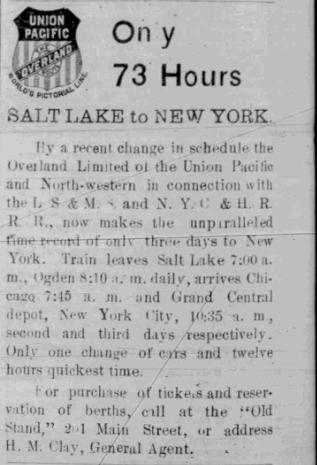Advertisements
During its 42-year run, Woman’s Exponent ran more than 4,000 advertisements, the majority of which were issued by small, local businesses. Doctors, shop owners, and teachers sought the attention of Woman’s Exponent’s female readership with enticing phrases like “Ladies will please call,” “Ladies are requested to call,” or “The Ladies of Utah are invited to visit.” Although we may be tempted to ignore these advertisements as we often do with ads today, they offer insights into women’s culture and commerce of the time. They provide information about who supported the Woman’s Exponent, who was selling what (and where) in Utah, and even intriguing details of a society making small strides towards equality.
Following the example of the Mining the Dispatch project at the University of Richmond, this page offers a complete collection of the advertising in the Woman’s Exponent along with maps, curated examples, and links to supporting materials. We have also provided a few of the most interesting examples.
Yes, Married Women Can Open Bank Accounts
From December 1897 through September 1906, Zion’s Savings Bank & Trust placed the same advertisement in The Woman’s Exponent. The only differences in this ad over those ten years were a change in interest rate (from 5% to 4% in September 1898) and the name of the bank’s president who was the current president of the Church of Jesus Christ of Latter-day Saints (from Wilford Woodruff to Lorenzo Snow to Joseph F. Smith).
One sentence in this ad may seem slightly out of place: After two paragraphs extolling the size (and, therefore, trustworthiness) of the bank, and before the description of the interest rate, the ad explains… “The laws of Utah permit married women and also children who are minors to open savings accounts in their own name, subject to their own order.”
Today we take for granted an individual’s right to control their own finances, but for 19th-century women—particularly married women—that right was new. Prior to 1888, married women in Utah were subject to the financial control of their husbands. Even after the new law, the traditional view continued so strongly that Zion’s Savings Bank was compelled to remind women who read The Woman’s Exponent of their rights.
The struggle for equal self-determination in financial matters was far from over. For example, American women waited 46 more years for equal-pay protections and 68 years for guaranteed equal access to personal credit.
Only Three Days to New York!
A direct flight from Salt Lake City to New York City lasts just over four hours in 2020. The same trip by car would take 34 hours. How long would that trip have taken for residents of the new State of Utah in 1898? Union Pacific Railroad boasted that it passengers could ride from Salt Lake City or Ogden, travel via Chicago, and arrive in New York City in only 73 hours, the fastest time by twelve hours.
This advertisement is more than just an amusing fact or a reminder of the luxuries we take for granted. It helps us understand the isolation that would be felt by citizens of far-away western states. While the writers of The Woman’s Exponent printed news from the suffragist movements on the East Coast and Europe, visiting those areas was no simple matter. It also highlights the difficulty New-York-based Susan B. Anthony and Elizabeth Cady Stanton would have had visiting the Utah territory in 1870 (28 years before Union Pacific’s 73-hour route).
To cite this webpage, use the following citation:
Browne, Jeremy. “Advertisements.” Woman’s Exponent Project, 2019. https://exhibits.lib.utah.edu/s/womanexponent/page/advertisements.






